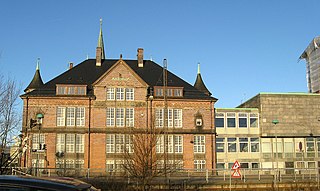Related Research Articles

Ole Christensen Rømer was a Danish astronomer who, in 1676, first demonstrated that light travels at a finite speed. Rømer also invented the modern thermometer showing the temperature between two fixed points, namely the points at which water respectively boils and freezes.

Jan Baptist van Helmont was a chemist, physiologist, and physician from Brussels. He worked during the years just after Paracelsus and the rise of iatrochemistry, and is sometimes considered to be "the founder of pneumatic chemistry". Van Helmont is remembered today largely for his 5-year willow tree experiment, his introduction of the word "gas" into the vocabulary of science, and his ideas on spontaneous generation.
The year 1900 in science and technology involved some significant events, listed below.

In Renaissance alchemy, alkahest was the theorized "universal solvent". It was supposed to be capable of dissolving any composite substance, including gold, without altering or destroying its fundamental components. By extracting from composite substances their fundamental virtues and properties, alchemists hoped to gain control of invaluable medical healing properties. For this reason the alkahest was earnestly sought. At the same time, its very existence was debated among alchemists and philosophers.
The year 1874 in science and technology involved some significant events, listed below.
The year 1868 in science and technology involved some significant events, listed below.
The year 1748 in science and technology involved some significant events.
The year 1737 in science and technology involved some significant events.
The year 1710 in science and technology involved some significant events.

The year 1625 in science and technology involved some significant events.
The year 1676 in science and technology involved some significant events.
The year 1648 in science and technology involved some significant events.
The year 1580 in science and technology included many events, some of which are listed here.
The year 1579 in science and technology included a number of events, some of which are listed here.

Aarhus Katedralskole is a cathedral school, an institution of secondary education, a Danish Gymnasium and a listed building in Aarhus, Denmark. The school is situated in the neighborhood Midtbyen, in the Latin Quarter, bounded by the streets Mejlgade, Kystvejen and Skolegyde. Aarhus Katedralskole offers the 3 year Matriculation examination (STX) programme with elective subjects in the natural sciences, social sciences and arts. The school is an independent self-owning institution financed by the Danish state with about 800 students divided across 30 classes.
Science Museums, Aarhus, founded 1 January 2008, is an umbrella organization comprising the Steno Museum, the greenhouses at Aarhus Botanical Gardens, the Ole Rømer Observatory and a herbarium in Aarhus, Denmark. The Science Museums works as an independent institution under the Science and Technology department of Aarhus University.

Ole Rømer Observatory is an astronomical observatory and museum, built in 1911 and located in Aarhus, Denmark. It is operated by Aarhus University and functions both as a research and training laboratory for the university Institute for Physics and Astronomy and a museum offering guided tours and lectures. It is named after astronomer Ole Rømer, and the buildings were listed in 2006 as a fine example of Danish Art Nouveau architecture. The facility also includes a residential house, originally and formerly home to the director of the observatory, today used as a guest house for visiting researchers.

This is a timeline of women in science, spanning from ancient history up to the 21st century. While the timeline primarily focuses on women involved with natural sciences such as astronomy, biology, chemistry and physics, it also includes women from the social sciences and the formal sciences, as well as notable science educators and medical scientists. The chronological events listed in the timeline relate to both scientific achievements and gender equality within the sciences.
Events from the year 1644 in Denmark.
References
- ↑ Sandifer, C. Edward (2007). How Euler Did It. MAA. p. 205. ISBN 9780883855638.
- ↑ Lehr, André (1991). The Art of the Carillon in the Low Countries. Tielt, Belgium: Lannoo. ISBN 90-209-1917-2.
- 1 2 "Jan Baptista van Helmont - Belgian scientist". Encyclopedia Britannica. Retrieved 3 April 2018.
- ↑ "Ole Rømer - Danish astronomer". Encyclopedia Britannica. Retrieved 3 April 2018.
- ↑ Vaquero, J. M.; Vázquez, M. (2009). The Sun Recorded Through History. Springer Science & Business Media. p. 236. ISBN 9780387927909.